Oct 16 2019
Layers of tungsten diselenide emit a highly unique kind of light. Thus far, the reason behind this has been unclear. Researchers at the Vienna University of Technology (TU Wien) have now come up with an explanation for this.
 Lukas Linhart (l) and Florian Libisch (r). (Image credit: TU Wien)
Lukas Linhart (l) and Florian Libisch (r). (Image credit: TU Wien)
For many years, this exotic phenomenon has remained unexplained: upon supplying energy to a thin layer of tungsten diselenide, it starts to glow in a very strange manner. Apart from ordinary light that is emitted by other semiconductor materials, tungsten diselenide also generates a unique kind of bright quantum light, produced only at particular points of the material.
It includes a series of photons always emitted one by one—and never in bunches or in pairs. Such an anti-bunching effect is ideal for experiments in the area of quantum cryptography and quantum information, which necessitate single photons. But for many years, this emission has stayed enigmatic.
Researchers at TU Wien have now found an explanation: A slight interaction between single atomic defects in the material and mechanical strain causes this quantum light effect. Computer simulations reveal how the electrons are pushed to particular positions in the material, where they are trapped by a defect, lose energy, and emit a photon.
Currently, the solution to this quantum light puzzle has been reported in the Physical Review Letters journal.
Only Three Atoms Thick
Tungsten diselenide—a so-called “two-dimensional material”—forms very thin layers with a thickness of only three atoms: tungsten atoms in the middle are linked to selenium atoms above and below.
If energy is supplied to the layer, for example by applying an electrical voltage or by irradiating it with light of a suitable wavelength, it begins to shine. This in itself is not unusual, many materials do that. However, when the light emitted by tungsten diselenide was analysed in detail, in addition to ordinary light a special type of light with very unusual properties was detected.
Lukas Linhart, Institute of Theoretical Physics, Vienna University of Technology
This unique kind of quantum light comprises photons of particular wavelengths, which are always emitted separately. Two photons of the same wavelength can never be detected at the same instance.
“This tells us that these photons cannot be produced randomly in the material, but that there must be certain points in the tungsten diselenide sample that produce many of these photons, one after the other,” explains Prof. Florian Libisch, spokesperson of the Graduate School TU-D at the TU Vienna with a focus on 2D materials.
This effect can be explained only with an in-depth insight into how the electrons in the material behave on a quantum physical level. Electrons in tungsten diselenide have the ability to fill different energy states.
A photon is emitted when an electron changes from a high-energy state to a lower energy state. But this jump to a lower energy is not always permitted: The electron must obey specific laws—the laws of conservation of momentum and angular momentum.
Defects and Distortions
These conservation laws stipulate an electron to remain in a high-energy quantum state unless specific defects in the material permit a change in the energy states.
A tungsten diselenide layer is never perfect. In some places one or more selenium atoms may be missing. This also changes the energy of the electron states in this region.
Lukas Linhart, Institute of Theoretical Physics, Vienna University of Technology
Furthermore, the material layer is not perfectly planar. Similar to a blanket that wrinkles upon spreading over a pillow, tungsten diselenide locally stretches if the material layer is suspended on small support structures. These mechanical stresses also influence the electronic energy states.
The interaction of material defects and local strains is complicated. However, we have now succeeded in simulating both effects on a computer. And it turns out that only the combination of these effects can explain the strange light effects.
Lukas Linhart, Institute of Theoretical Physics, Vienna University of Technology
At the material’s microscopic regions at which surface strains and imperfections appear together, the electrons’ energy levels change from a high-energy state to a lower energy state, emitting a photon. Since the laws of quantum physics forbid the two electrons from being in exactly the same state at the same instance, it is necessary for the electrons to undergo this process one by one. Thus, the photons are also emitted one by one.
Meanwhile, the material’s mechanical distortion helps to pile up numerous electrons close to the defect. This ensures that another electron is readily available to step in as soon as the last one changes its state and emits a photon.
This outcome shows that ultrathin 2D materials pave the way for totally new possibilities for materials science.